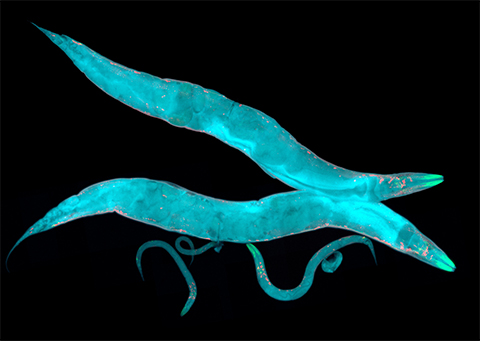From the journals: MCP
Lysosomal proteins differ across cell lines. Reducing background in protein identification. Stress-related differences in protein sugars. Read about papers on these topics recently published in the journal Molecular & Cellular Proteomics.
Stress-related differences in protein sugars

Protein glycosylation is the enzymatic addition of sugars, or glycans, to a target protein after translation that influences how the protein folds and functions. The extent of protein glycosylation can change in an organism during different developmental stages. Iain Wilson from the University of Natural Resources and Life Sciences in Vienna, Austria, and an international team of researchers discovered that the way the nematode Caenorhabditis elegans is cultivated also influences the level of glycosylation in its cells. In a recent paper in the journal Molecular & Cellular Proteomics, the researchers described their findings on the range of N-glycans, linked to the asparagine amino acids of proteins, in C. elegans from embryo to larva.
C. elegans contains only about 1,000 body cells and has a complex glycosylation profile, or glycome, including over 200 different N-glycan structures. Previous studies have investigated the level of RNA transcripts of glycosylation enzymes. While the set of glycan structures found in C. elegans does not correlate with the number of enzyme transcripts, researchers have found evidence that glycosylation-relevant genes are expressed in a coordinated way.
To profile glycomes, Wilson’s team cut the glycans from collected proteins using enzymes called peptide-N-glycosidases, or PNGases. The researchers discovered no difference in the embryonal glycome of wild-type C. elegans and two mutants with developmental defects. However, they found a clear difference in the glycome between liquid- and plate-grown worms in the fourth larval stage, known as L4. Liquid-grown L4 larvae have about three times more structures with a galactose sugar in an alpha position linked to mannose, and/or methylation of other sugar units, than plate-grown larvae. The researchers hypothesize that this shift is stress related, having to do with the different conditions under which the C. elegans is grown; being shaken in liquid is unlike their natural soil habitat!
Lysosomal proteins differ across cell lines
Lysosomes are the main organelles responsible for degrading and recycling compounds in mammalian cells. Lysosomal malfunction can result in rare diseases and has been shown to impact more common diseases, including cancer. However, all lysosomes are not the same between cell types. In a new study in the journal Molecular & Cellular Proteomics, Fatema Akter, Sara Bonini and Srigayatri Ponnaiyan from the University of Bonn, in collaboration with researchers from the Bangladesh Agricultural University and the University of Kiel, identified a distinct population of lysosomal proteins over six cell lines and discovered many potentially novel lysosomal proteins.
Using nanoparticles for protein binding, the researchers identified lysosomal proteins in the cell lines HEK293, HeLa, HuH-7, SH-SY5Y, MEF and NIH3T3 with mass spectrometry, reverse transcription polymerase chain reaction and immunostaining techniques. Most of the identified proteins were detected across all the cell lines, forming a core proteome that is highly conserved among the lysosomes of different lines. SH-SY5Y cells were the most similar to other cell lines, and NIH3T3 cells were least similar. The researchers analyzed protein abundance across functions as well, finding patterns in the abundance of transporter proteins, the mammalian target of rapamycin complex and hydrolysis of glycosidic bonds.
Reducing background in protein identification
When a cell is exposed to stimuli or stress, the pattern of messenger RNA expression and protein synthesis changes. Newly synthesized, or nascent, proteins can provide important information on what biochemical processes are occurring when the cell responds. Profiling these proteins in the presence of preexisting cellular proteins requires specific labeling and purification protocols. Nancy J. Phillips and the team from the University of California, San Francisco, optimized a method for nascent protein detection by incorporating a cleavable linker molecule, as described in a recent paper in the journal Molecular & Cellular Proteomics.
To selectively label nascent proteins, the researchers introduced the antibiotic analog O-propargyl-puromycin, or OPP, to the cell. It entered the A-site of the ribosome and was incorporated randomly at the C terminus of the polypeptide chain. This resulted in truncated, OPP-labeled nascent proteins. The researchers then used click chemistry to attach a biotin molecule with a cleavable linker. This biotin molecule could be captured on streptavidin beads. The beads could then be washed and the nascent proteins selectively released by chemical cleavage, leaving behind nonspecific binders. Purified proteins were then characterized by liquid chromatography–mass spectrometry. This method greatly reduced background protein levels and enabled analysis of nascent proteins at low concentrations.
Enjoy reading ASBMB Today?
Become a member to receive the print edition four times a year and the digital edition monthly.
Learn moreGet the latest from ASBMB Today
Enter your email address, and we’ll send you a weekly email with recent articles, interviews and more.
Latest in Science
Science highlights or most popular articles

Defining a ‘crucial gatekeeper’ of lipid metabolism
George Carman receives the Herbert Tabor Research Award at the ASBMB Annual Meeting, March 7–10, just outside of Washington, D.C.

The science of staying strong
Muscles power every movement, but they also tell the story of aging itself. Scientists are uncovering how strength fades, why some species resist it and what lifestyle and molecular clues could help preserve muscle health for life.

Bacteriophage protein could make queso fresco safer
Researchers characterized the structure and function of PlyP100, a bacteriophage protein that shows promise as a food-safe antimicrobial for preventing Listeria monocytogenes growth in fresh cheeses.

Building the blueprint to block HIV
Wesley Sundquist will present his work on the HIV capsid and revolutionary drug, Lenacapavir, at the ASBMB Annual Meeting, March 7–10, in Maryland.

Gut microbes hijack cancer pathway in high-fat diets
Researchers at the Feinstein Institutes for Medical Research found that a high-fat diet increases ammonia-producing bacteria in the gut microbiome of mice, which in turn disrupts TGF-β signaling and promotes colorectal cancer.

Mapping fentanyl’s cellular footprint
Using a new imaging method, researchers at State University of New York at Buffalo traced fentanyl’s effects inside brain immune cells, revealing how the drug alters lipid droplets, pointing to new paths for addiction diagnostics.

